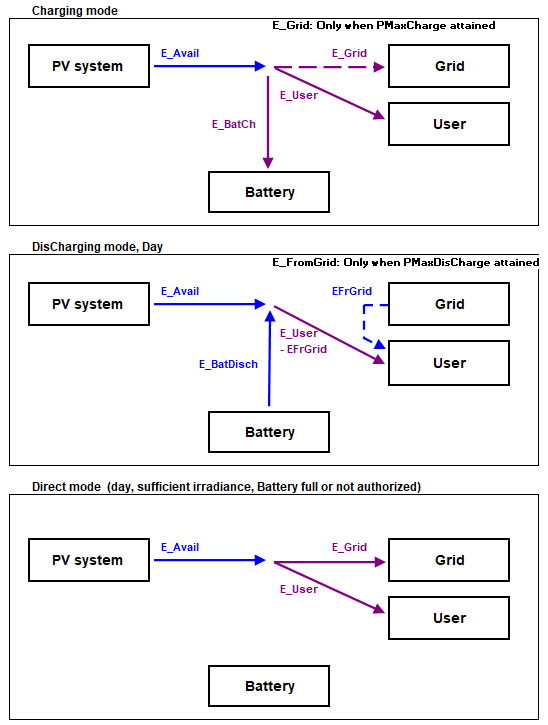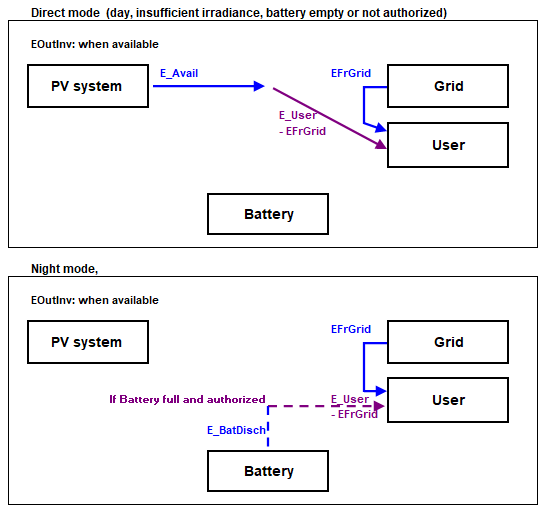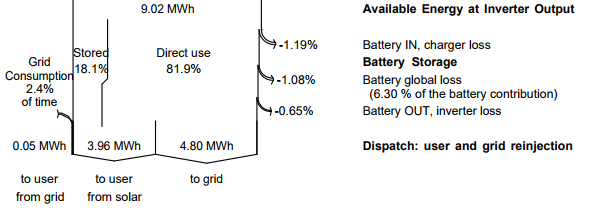Self consumption with storage
The self-consumption strategy with storage may have different objectives:
- Consuming its own PV produced energy, and draw a minimum of energy from the grid, whatever the price.
- Optimizing the cost of the electricity. This is in the case of a high price of the electricity from the grid, and a low price of the re-injected energy. For being profitable, the difference should be higher than the price of the stored energy. If the tariffs are time-dependent during the day, this may involve a specific charging/discharging strategy, which is not yet implemented.
- For the grid management, re-injecting the energy when needed by the community. This is not possible to manage in the simulation, as the real state of the grid at each time is not known.
In this first attempt, only the first option is implemented: the energy is stored in the battery, as soon as available (i.e. when the PV production overcomes the user's needs), and is "immediately" used for satisfying the internal needs up to the battery is empty.
In this mode, the energy of the battery is never re-injected into the grid. Keep in mind that the User's consumption and the grid are the same AC circuit. Practically, the control device and the battery inverter should be able to modulate the power, in order to exactly feed the user's consumption.
If we define:
- E_Avail - energy available after all losses behind the inverter: E_Avail = EoutInv - EAuxLss - EUnavail - EAcOhmL - ETrfLss
- E_User - internal user's needs (consumption), defined in hourly values
- E_Grid - excess PV energy, injected into the grid
- EFrGrid - back-up energy drawn from the grid
- EBatCh - the energy stored into the battery
- EBatDis - the energy drawn from the battery
We have the following operating modes:
The charging or discharging are limited by the PMaxCharge of the charger, or the PMaxDischarge of the battery inverter.
Sizing
For a domestic-like installation:
- First evaluate the average daily energy needs from the user's needs (load) profile [kWh/day] (shown on the dialog)
- The PV array should be able to produce this energy for most of the year's days.
- For an "efficient" independence on the grid, the battery pack should store at least one to 2 days of consumption, ideally 3 or 4.
Now there are some additional constraints to this sizing:
- The battery charging should not be too quick: for Lead-acid batteries, a charge in 3 hours is the minimum reasonable for the lifetime of the battery. Li-Ion batteries support higher currents (up to 1 hour). This should be limited by the charger maximum power. The possible excess power energy will be injected into the grid. If this is not desired, the maximum PV power [kWp] should be able to charge the battery in 3-5 hours minimum.
- The inverter maximum power (at the output of the battery) should be sufficient for feeding the maximum power required by the user. Again, the maximum discharge current should not be excessive (C3, i.e. discharge in 3 hours, for lead-acid, around C1 for Li-ion). If these powers are exceeded, the battery capacity should be increased. This may be the case when the full consumption of the day is concentrated on a short time.
Simulation and results
After the simulation, the balances of all these energy flux will appear on the loss diagram:
The diagram shows:
| The amount of stored energy (with respect to direct use), which has an impact on the cycling, i.e. the battery lifetime and cost of the stored energy. This is highly related to the user's needs profile, i.e. if the energy is mainly consumed during the solar availability or not. This may be improved by a severe demand-side energy management (DSM), i.e. switching the appliances from night to specific periods of the day. | |
| EBatCh - EBatDis | The battery energy loss due to the charging/discharging faradic efficiency, internal resistance, eventual gassing (lead-acid) or over-current due to overcharging, etc. |
| CL_Chrg | The operating losses in the battery charger (inefficiency). |
| CL_InvB | The operating losses in the battery inverter (inefficiency). |
| E_User | the total energy consumed by the user (i.e. the specified hourly load profile), which is split into: |
| E_Solar | the user's consumption coming from the sun |
| EFrGrid | the missing energy, drawn from the grid when the PV is not sufficient (especially by night) |
| SolFrac | we name "Solar Fraction" the ratio of the user's energy from solar, to the total user's consumption. |
| E_Grid | the excess energy, injected into the grid. This is essentially related to the PV array power / User's consumption ratio. |
| E_Unused | is the same energy quantity as E_Grid above, when the reinjection into the grid is not allowed. |
The relative values of the energies in this final balances are highly dependent on the sizing. This result should be a guide for optimizing the system according to your criteria.


